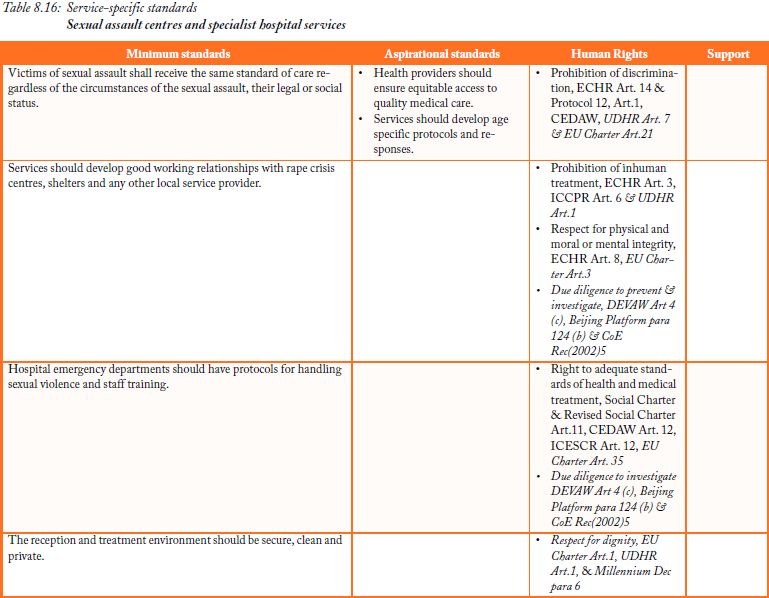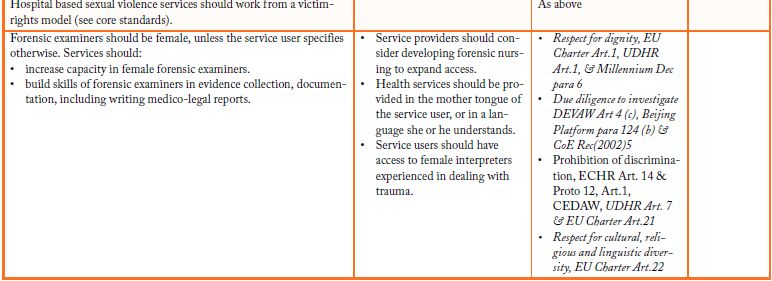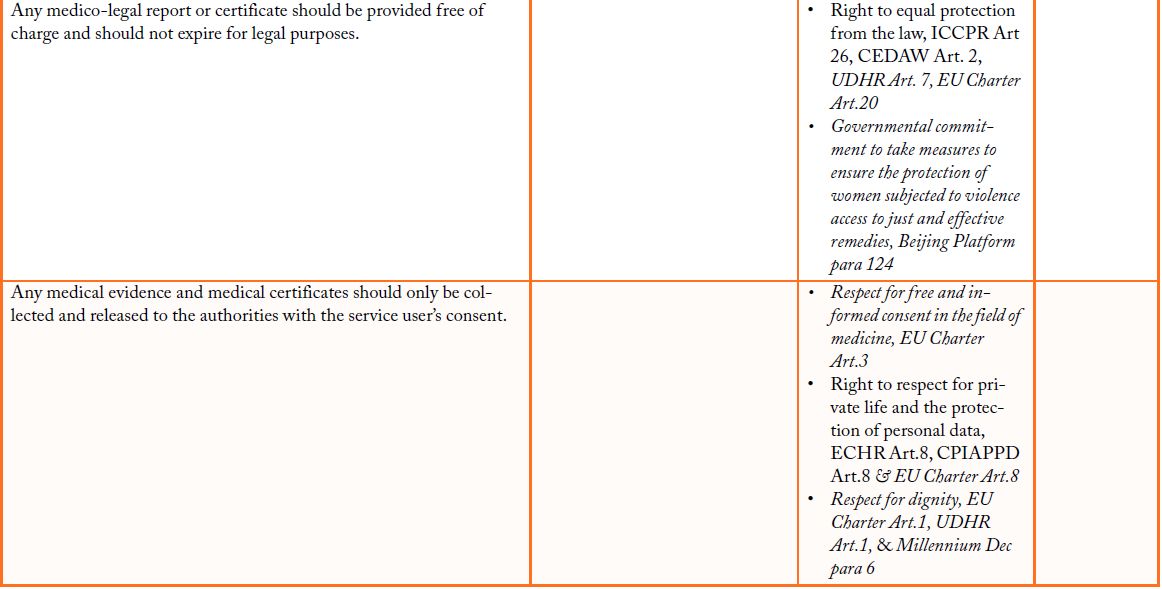- Intimate partner violence and/or sexual assault centres, also referred to as One-Stop Centres, provide multisectoral case management for survivors, including health, welfare, counselling, and legal services in one location (Colombini et al., 2008). These crisis centres are typically located in health facilities, including the emergency departments of hospitals, or as stand-alone facilities near a collaborating hospital (United Nations, 2006a). These centres can be staffed with specialists 24 hours or can maintain a core group of staff with specialists on call.
One-stop Centres
One of the best-known good practices in service provision involves bringing together services in one location, often called the “One-stop centre”, an interagency unit for victim/survivors of domestic or sexual violence. Such a service was first developed in the largest Government-run general hospital in Malaysia. The victim/survivor is first examined and treated by a doctor and is seen by a counsellor within 24 hours in a separate examination room that protects privacy and confidentiality. If it appears that the victim will be in danger if she returns home, the doctor or counsellor arranges for her to go to an emergency shelter or admits her to the accident and emergency ward for 24 hours. If the patient chooses not to seek shelter, she is encouraged to return to see a social worker at the hospital at a later date. She is also encouraged to make a police report at the police unit based in the hospital. In a case involving severe injury, the police see the patient in the ward to record her statement and start investigations. This model is currently being replicated in many parts of the world.
Search the Secretary-General's Database to see which countries have established integrated service centres.
Source: adapted from the Secretary-General's in-depth study on violence against women, 2006.
- It has been shown that when comprehensive one-stop shops are adequately resourced, staffed and managed, reporting and demand for services increases. For example, following the introduction of comprehensive post-rape care services, the reporting of rape was ten times higher in the following three months at a district hospital in Kenya (Taegtmeyer et al., 2006).
- However, one-stop centres require the commitment of administrators in order to be effective, as well as training and support for all staff working within the centre. Key lessons learned from implementing a one-stop centre in Thailand include:
- Hospital management must be involved in the establishment of one-stop crisis centres
- Teamwork among various hospital personnel is crucial
- Training for various hospital staff should focus not only on technical aspects of violence against women, but should also cover issues such as power, relationships, gender and sexuality.
- Sensitization of police on the same issues is also important.
- Visits to other crisis centres can be a useful starting point for designing services.
- Initially, health care providers may identify only the most obvious cases of abuse, but sharing of experiences between personnel in various departments of the hospital can improve screening skills in general.
- Adherence to a standard protocol for various health care workers is necessary. (Excerpted from WHO, 2007)
- The Council of Europe recommends the following minimum services for sexual assault centres located in health facilities, which can be used as a baseline to consider priorities for programme development:





Source: Council of Europe, Kelly, L. 2008a. Combating Violence against Women: Minimum Standards for Support Services. Strasbourg: Council of Europe, pgs. 51-53.
See the brochure developed by the National Prosecuting Authority of South Africa.
Read more about the centres and see a list of locations by visiting the UNICEF South Africa website.
Example: The United Kingdom has created a system of Sexual Assault Referral Centers, safe locations where victims of sexual assault can receive immediate and longer-term medical care and counseling. The referral centers bring together all of the relevant legal and medical agencies and departments in a single center, which provides better assistance for the victim and aids criminal investigation. The system is modeled after the St. Mary’s Sexual Assault Referral Centre in Manchester, which has been recognized as a model of good practice in providing immediate and “one-stop” services. The St. Mary’s Center opened in 1986 and was the first such center in the United Kingdom to provide comprehensive and coordinated forensic, counseling and medical services to adults who had experienced rape or sexual assault. For victims the referral centers system reduces the stress of having to deal with multiple service providers and criminal investigators. Furthermore, practice has shown that victims who receive immediate care and counseling recover more steadily and are less likely to need long-term care. From the perspective of law enforcement, the centers assist the police by providing a centralized facility where they can meet with the victim and gather evidence.
See the UK Home Office website for more information.
Source: Excerpted from Bringing Security Home: Combating Violence Against Women in the OSCE Region. A Compilation of Good Practices (Organization for Security and Co-operation in Europe, 2009). OSCE Secretariat, Office of the Secretary General, Gender Selection, pg. 83.
Example: The President’s Family Justice Center Initiative, a $20 million USD federal programme to create specialized “one stop shop” multi-disciplinary service centers in the US for victims of family violence and their children, was launched in 2003. The centers are modeled after the San Diego Family Justice Center, which is considered a good practice in the field of victim services. The San Diego Family Justice Center model reduces the number of institutions that a victim of domestic violence, sexual assault and/or elder abuse must go to in order to receive assistance. The family justice center model has several effective features. For example, all relevant partners to a multi-disciplinary approach are co-located at the center (law enforcement, prosecutors, probation officers, victim advocates, attorneys, healthcare professionals as well as staff representing other community organizations and faith groups). The communities in which these centers are located have policies that emphasize arrest and prosecution of offenders– as well as a history of collaboration among law enforcement, government agencies and civil society. Victim safety, advocacy and confidentiality are the highest priorities under the family justice center model. The family justice centers are located in communities with well-developed specialized services for domestic violence victims and also receive local support from policymakers and the community at large.
See the Family Justice Center website for more information.
Source: excerpted from Bringing Security Home: Combating Violence Against Women in the OSCE Region. A Compilation of Good Practices (Organization for Security and Co-operation in Europe, 2009).. OSCE Secretariat, Office of the Secretary General, Gender Selection, pg. 83.
Resources:
A Review and Evaluation of Multi-Sectoral Response Services (“One-Stop Centers”) for Gender-Based Violence in Kenya and Zambia (Keesbury et al./Population Council and UNICEF, 2012). Available in English.
